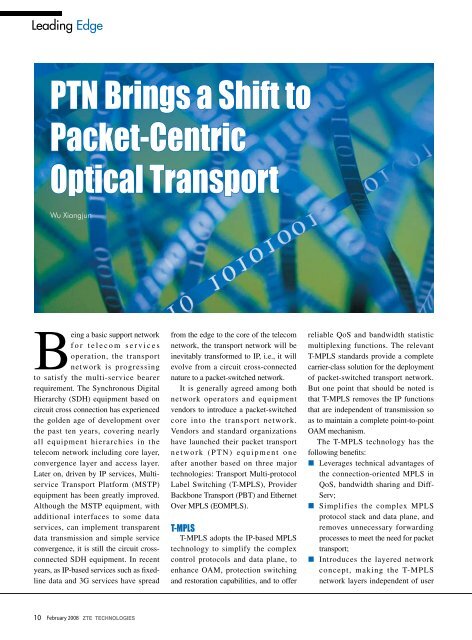PDF download - ZTE
PDF download - ZTE
PDF download - ZTE
Create successful ePaper yourself
Turn your PDF publications into a flip-book with our unique Google optimized e-Paper software.
Leading Edge<br />
PTN Brings a Shift to<br />
Packet-Centric<br />
Optical Transport<br />
Wu Xiangjun<br />
Being a basic support network<br />
f o r t e l e c o m s e r v i c e s<br />
operation, the transport<br />
network is progressing<br />
to satisfy the multi-service bearer<br />
requirement. The Synchronous Digital<br />
Hierarchy (SDH) equipment based on<br />
circuit cross connection has experienced<br />
the golden age of development over<br />
the past ten years, covering nearly<br />
all equipment hierarchies in the<br />
telecom network including core layer,<br />
convergence layer and access layer.<br />
Later on, driven by IP services, Multiservice<br />
Transport Platform (MSTP)<br />
equipment has been greatly improved.<br />
Although the MSTP equipment, with<br />
additional interfaces to some data<br />
services, can implement transparent<br />
data transmission and simple service<br />
convergence, it is still the circuit crossconnected<br />
SDH equipment. In recent<br />
years, as IP-based services such as fixedline<br />
data and 3G services have spread<br />
10 February 2008 <strong>ZTE</strong> TECHNOLOGIES<br />
from the edge to the core of the telecom<br />
network, the transport network will be<br />
inevitably transformed to IP, i.e., it will<br />
evolve from a circuit cross-connected<br />
nature to a packet-switched network.<br />
It is generally agreed among both<br />
network operators and equipment<br />
vendors to introduce a packet-switched<br />
core into the transport network.<br />
Vendors and standard organizations<br />
have launched their packet transport<br />
n e t work ( P T N ) e q u i p m e n t o n e<br />
after another based on three major<br />
technologies: Transport Multi-protocol<br />
Label Switching (T-MPLS), Provider<br />
Backbone Transport (PBT) and Ethernet<br />
Over MPLS (EOMPLS).<br />
T-MPLS<br />
T-MPLS adopts the IP-based MPLS<br />
technology to simplify the complex<br />
control protocols and data plane, to<br />
enhance OAM, protection switching<br />
and restoration capabilities, and to offer<br />
reliable QoS and bandwidth statistic<br />
multiplexing functions. The relevant<br />
T-MPLS standards provide a complete<br />
carrier-class solution for the deployment<br />
of packet-switched transport network.<br />
But one point that should be noted is<br />
that T-MPLS removes the IP functions<br />
that are independent of transmission so<br />
as to maintain a complete point-to-point<br />
OAM mechanism.<br />
The T-MPLS technology has the<br />
following benefits:<br />
■ Leverages technical advantages of<br />
the connection-oriented MPLS in<br />
QoS, bandwidth sharing and Diff-<br />
Serv;<br />
■ Simplifies the complex MPLS<br />
protocol stack and data plane, and<br />
removes unnecessary forwarding<br />
processes to meet the need for packet<br />
transport;<br />
■ Introduces the layered network<br />
concept, making the T-MPLS<br />
network layers independent of user

















